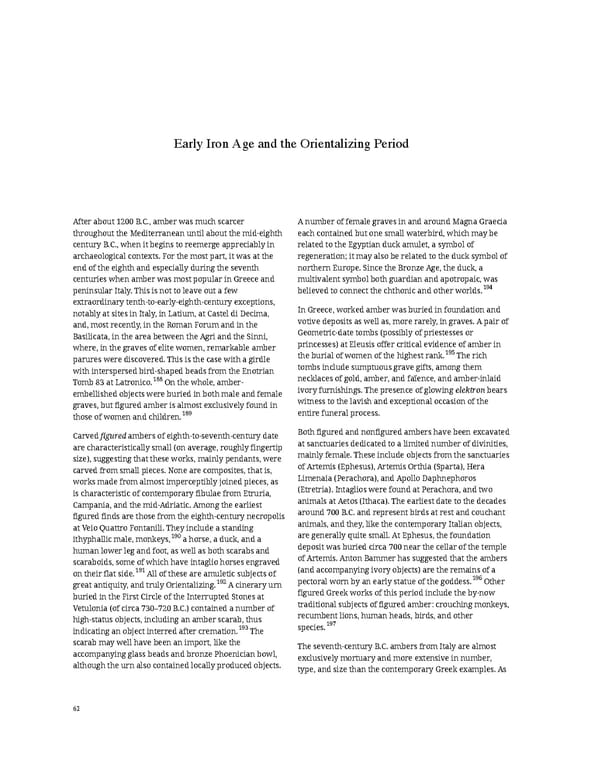Early Iron Age and the Orientalizing Period After about 1200 B.C., amber was much scarcer A number of female graves in and around Magna Graecia throughout the Mediterranean until about the mid-eighth each contained but one small waterbird, which may be century B.C., when it begins to reemerge appreciably in related to the Egyptian duck amulet, a symbol of archaeological contexts. For the most part, it was at the regeneration; it may also be related to the duck symbol of end of the eighth and especially during the seventh northern Europe. Since the Bronze Age, the duck, a centuries when amber was most popular in Greece and multivalent symbol both guardian and apotropaic, was peninsular Italy. This is not to leave out a few believed to connect the chthonic and other worlds.194 extraordinary tenth-to-early-eighth-century exceptions, notably at sites in Italy, in Latium, at Castel di Decima, In Greece, worked amber was buried in foundation and and, most recently, in the Roman Forum and in the votive deposits as well as, more rarely, in graves. A pair of Basilicata, in the area between the Agri and the Sinni, Geometric-date tombs (possibly of priestesses or where, in the graves of elite women, remarkable amber princesses) at Eleusis offer critical evidence of amber in the burial of women of the highest rank.195 The rich parures were discovered. This is the case with a girdle with interspersed bird-shaped beads from the Enotrian tombs include sumptuous grave gifts, among them Tomb 83 at Latronico.188 On the whole, amber- necklaces of gold, amber, and faïence, and amber-inlaid embellished objects were buried in both male and female ivory furnishings. The presence of glowing elektron bears graves, but figured amber is almost exclusively found in witness to the lavish and exceptional occasion of the those of women and children.189 entire funeral process. Carvedfiguredambers of eighth-to-seventh-century date Both figured and nonfigured ambers have been excavated are characteristically small (on average, roughly fingertip at sanctuaries dedicated to a limited number of divinities, size), suggesting that these works, mainly pendants, were mainly female. These include objects from the sanctuaries carved from small pieces. None are composites, that is, of Artemis (Ephesus), Artemis Orthia (Sparta), Hera works made from almost imperceptibly joined pieces, as Limenaia (Perachora), and Apollo Daphnephoros is characteristic of contemporary fibulae from Etruria, (Etretria). Intaglios were found at Perachora, and two Campania, and the mid-Adriatic. Among the earliest animals at Aetos (Ithaca). The earliest date to the decades figured finds are those from the eighth-century necropolis around 700 B.C. and represent birds at rest and couchant at Veio Quattro Fontanili. They include a standing animals, and they, like the contemporary Italian objects, ithyphallic male, monkeys,190 a horse, a duck, and a are generally quite small. At Ephesus, the foundation human lower leg and foot, as well as both scarabs and deposit was buried circa 700 near the cellar of the temple scaraboids, some of which have intaglio horses engraved of Artemis. Anton Bammer has suggested that the ambers on their flat side.191 All of these are amuletic subjects of (and accompanying ivory objects) are the remains of a 192 pectoral worn by an early statue of the goddess.196 Other great antiquity, and truly Orientalizing. A cinerary urn buried in the First Circle of the Interrupted Stones at figured Greek works of this period include the by-now Vetulonia (of circa 730–720 B.C.) contained a number of traditional subjects of figured amber: crouching monkeys, high-status objects, including an amber scarab, thus recumbent lions, human heads, birds, and other 193 species.197 indicating an object interred after cremation. The scarab may well have been an import, like the The seventh-century B.C. ambers from Italy are almost accompanying glass beads and bronze Phoenician bowl, exclusively mortuary and more extensive in number, although the urn also contained locally produced objects. type, and size than the contemporary Greek examples. As 62
 Ancient Carved Ambers in the J. Paul Getty Museum Page 71 Page 73
Ancient Carved Ambers in the J. Paul Getty Museum Page 71 Page 73